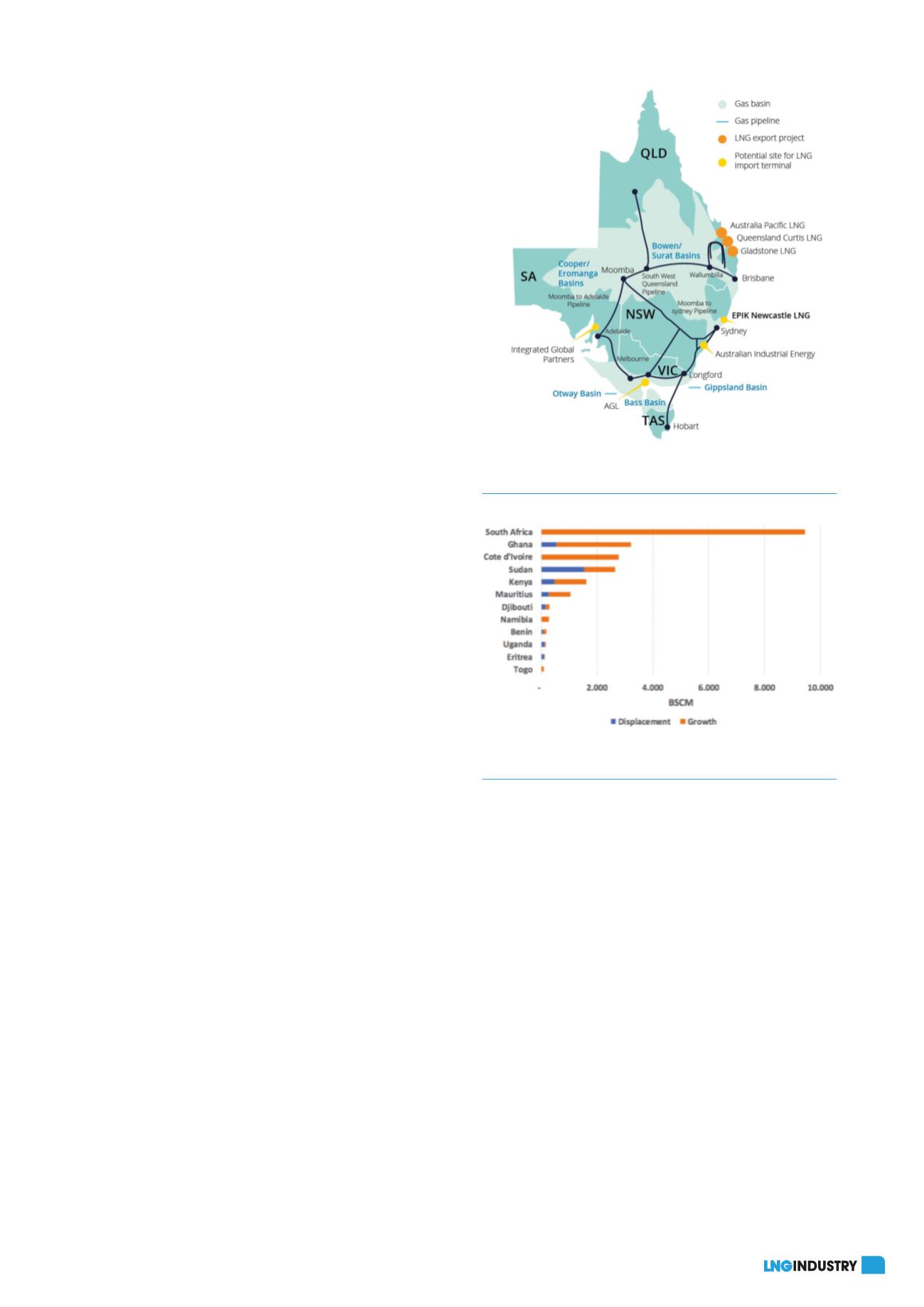
January 2020
15
In August 2018, Excelerate commissioned the Moheshkhali
floating LNG (FLNG) terminal, Bangladesh’s first LNG import
facility.
8
A second FLNG import terminal commenced operations
offshore Moheshkhali Island earlier last year.
Bangladesh is switching focus to land-based developments
and building its first onshore LNG import terminal, a
7.5 million tpy operation, including receiving, unloading, storage
and regasification. According to Reuters, at least 12 companies
are bidding for the project including QP, Exxon-Mobil, Total,
Samsung and Shell.
9
The decision to focus onshore may reflect the painful
lessons learnt from Bangladesh’s first FLNG terminal where
technical issues and adverse weather events delayed LNG
shipments. A land-based terminal with larger import capacity
has more attractive economics than smaller floating storage
and regasification units (FSRUs), which typically work better
with short-term and mid-term demand. There is a finite window
of opportunity too. Bangladesh has shortlisted 17 companies for
its spot tender process planning to buy approximately
1 million tpy of LNG in 2020 to capitalise on low gas prices.
10
Australia
Strange things do happen. Australia is about to find itself in the
position of being both a producer and consumer of LNG.
11
A spike in domestic gas prices, driven in part by the
demand-pull of the Gladstone LNG export projects, together
with domestic gas supply shortfalls and high production costs,
has opened the door to LNG imports.
Energy affordability and security are frontline political
issues with Australian households and businesses wilting under
the pressure of high gas prices.
Building a trans-continental gas pipeline from the west
– where gas is in relatively plentiful supply – to customer
demand centres on the east coast is highly capital intensive.
Developing Greenfield gas fields faces numerous regulatory and
environmental barriers, not least moratoriums on onshore gas
development imposed by several states. LNG import terminals
are the path of least resistance.
There are currently five proposed LNG terminal projects.
Some have targeted startup dates as early as 2020. From a
project developer perspective, time is of the essence as the
current gas shortage enhances project economics and will
likely support at least one import terminal, possibly more.
Indonesia
Indonesia is a country abandoning plans to import LNG
following several major gas discoveries. The strategic plan
to attract overseas upstream investment has paid dividends
with major discoveries and project approvals fundamentally
changing Indonesia’s gas production outlook. What’s more,
faced with lower wholesale electricity prices, Indonesian power
plants are leaning on cheaper coal. All of this has curtailed
investment in domestic gas infrastructure and reduced
Indonesia’s need for LNG imports.
Africa
Africa represents a big commercial opportunity for LNG given
the size of the population, rising living standards, energy
demand outlook and shift towards cleaner energy sources.
Like many of the emerging LNG customer markets, Morocco
is a net energy importer looking to diversify energy supply and
reduce dependence on foreign oil and coal. Morocco’s 2030
vision plans for more gas-fired power plants and renewables.
The bid process for Morocco’s LNG import terminal in Jorf Lasfar
is still ongoing with the project not expected until 2025. Typical
of many of the projects we see in the emerging markets, this is
an integrated gas-to-power project consisting of an LNG import
terminal, marine jetty, gas pipeline network and a 2400 MW
combined cycle gas turbine.
Another African nation tilting towards LNG is Ghana, set to
be the very first sub-Saharan nation to buy LNG. Backed by
private equity, Ghana signed a deal in September 2018 with
two Chinese engineering firms to build the 2 million tpy
Tema FLNG import facility. The project is due for completion in
2020.
12
Other countries in the West African Power Pool (WAPP) — a
collective of interconnected electricity grids across national
borders – are also looking to build LNG import capacity. This is
a big list of countries including: Mali, Burkina Faso, Niger,
Senegal, Gambia, Guinea-Bissau, Guinea, Sierra Leone, Liberia,
Côte d’Ivoire, Togo, Benin and Nigeria.
South Africa is pushing to diversify its energy sources away
from coal, which supplies more than 90% of electricity.
State-owned freight logistics firm Transnet plans to launch a
tender this year for South Africa’s first LNG import terminal at
Figure 5.
Potential demand growth in gas importing
countries.
Figure 4.
LNG import proposals in Australia’s east coast gas
market.








